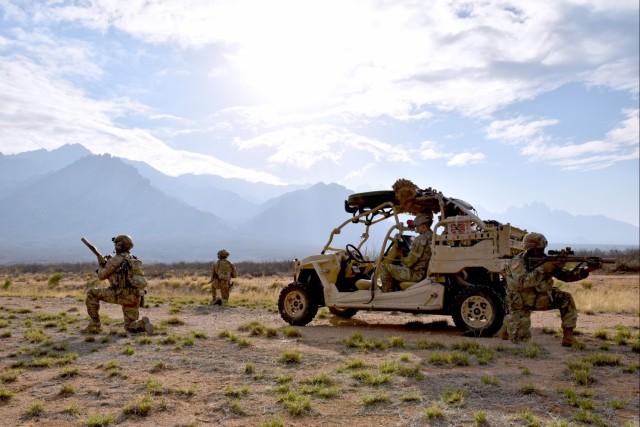WHITE SANDS MISSILE RANGE, N.M. -- Partnering with joint and coalition forces, U.S. Army Space and Missile Defense Command’s 1st Space Brigade continues to experiment with new tactical space control technology to support the warfighter in increasingly complex and contested environments.
Soldiers with the brigade’s 18th Space Company participated in experimentation at White Sands Missile Range during Project Convergence-Capstone 4 from mid-February into early March to advance the Army space, cyber and special operations forces “Triad’s” ability to conduct space operations at the tactical edge.
Project Capstone, an experiment hosted by U.S. Army Futures Command, saw warfighters from across the U.S. military and allied countries including the Five Eyes nations – United States, United Kingdom, Canada, Australia and New Zealand – as well as France and Japan, explore the future of warfighting communications, operations and maneuver.
As part of the first phase of PC-C4, these space Soldiers experimented with a system to determine if it fulfilled the Army’s current demand for a ruggedized, tactical space control system.
While the brigade’s current program of record is mobile, the Army is seeking technology that allows the capability to be hand-carried by the Soldiers themselves or transported by small tactical vehicles.
“Larger space capabilities cannot effectively integrate with more expeditionary units, such as SOF,” said Capt. Noah Siegel, Triad Experimentation Team platoon leader, 18th Space Company. “Shrinking our equipment and focusing on mobility allows our Soldiers to provide space support to units of all types at or beyond the tactical edge. For warfighters on the ground, this tactical space support enables the synchronization and convergence of joint and multidomain effects to enhance lethality.”
Amid the desert scrub and sand at the base of the Organ Mountains, the 1st Space Brigade Soldiers operated the system from the back seat of the utility task vehicle – driven by soldiers with the British Army Special Operations Brigade – to demonstrate how space operations crews not only support American SOF partners but integrate with friendly coalition forces.
At the tactical level, Army space capabilities, such as this system, would enhance ground maneuver formations’ ability to see, sense, stimulate, strike and assess across the spectrum. Special operations forces allow space Soldiers deeper physical access into austere operating environments.
“It was great to see the similarities and differences in how space, signal, cyber, as well as U.S., U.K., and Australian SOF partners operate,” said Sgt. Jon Rizzo, 18th Space Company. “We enjoyed working with these forces and exploring where and how we can fit in.”
Though the system is not an Army program of record, experimentation initiatives such as PC-C4 allow the Army to assess the suitability of certain equipment to inform future programs of record.
Data and lessons learned from the brigade’s experimentation during PC-C4 was presented at Camp Pendleton, California, to Department of Defense senior leaders, allies and partners on March 4-5.










Social Sharing